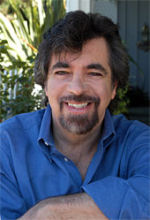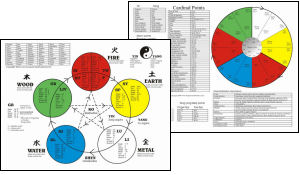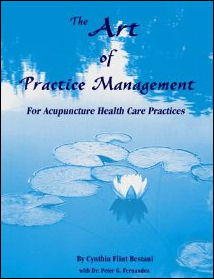Acupuncture & TCM Articles

Neil R. Gumenick is the founder and Director of The Institute of Classical Five-Element Acupuncture. Neil is a Worsley certified advanced teacher of Classical Five-Element Acupuncture and a practitioner with over 27 years of private practice experience. Neil holds three degrees from the College of Traditional Acupuncture (U.K.), and he participated for 10 years in the Master Apprentice Programô, led by Profs. J.R. & J.B. Worsley. Neil has taught at the USC and UCLA Schools of Medicine, the Worsley Institute of Classical Acupuncture, the Traditional Acupuncture Foundation, California Acupuncture College, Santa Barbara College of Oriental Medicine, and Pacific College of Oriental Medicine. He has been a Professor at Emperor's College of Traditional Oriental Medicine and SAMRA University of Oriental Medicine. Neil is co-author of The Art of Practice Management for Acupuncture Health Care Practices
Practitioner/Patient Rapport:
Developing Rapport with the Emotion of the Water Element, Part Two of Two
By Neil Gumenick, MAc (UK), LAc, Dipl. Ac
Reassurance during the Examination
As I discussed earlier in this series on rapport, I recommend beginning the session with some small talk, shifting so seamlessly into the "interview" that the patient does not even sense that a formal examination has begun.
Otherwise, what began as a safe and friendly interchange between two equals becomes an "interrogation," and the patient's defensive mask will go up. At that point, you are not in rapport and little of what the patient says from that point will be of any value in terms of revealing what his or her real needs are.

Be concerned with the patient's comfort. Ask if the patient would like water or perhaps tea, if the room could be warmer or cooler, or if the window should be open. Ask if he or she is comfortable in the chair or would rather lie on the table (particularly in the case of pain syndromes). Make sure that tissues, extra pillows and blankets are available. Between the interview and physical examination, give the patient a chance to ask questions, raise issues, and take a bathroom break.
The opening of the physical exam (when you ask the patient to undress and lie on the table) is a vulnerable moment. There are many ways to give this direction. Be aware of how you give it and how the patient responds. Is there blushing; averting of eyes; or body language that expresses discomfort or embarrassment? If the rapport seems broken, give reassurance of your concern for the patient's modesty. Have clean sheets and dressing gowns readily available. Tell the patient exactly what you need him/her to do. You might say, "I need you to undress down to your underclothes. Here is a gown and I'll need the opening in front. You can cover up with this sheet. I'll be back in a few moments when you are ready." Leave the room while the patient complies. Knock before re-entering.
Let there be no surprises. Patients generally do not know what to expect when they visit an acupuncturist, so explain what you are going to do a little bit at each stage. For example, if you are going to palpate the three jiao, explain that you will be uncovering the chest and abdomen for a few moments and placing your hand in different areas to check the distribution of heat. Be aware of how you are touching and how the patient responds.
Even the taking of the pulses will be a new, and perhaps strange, experience for the patient. Explain in your own words that unlike Western medicine, which measures one pulse, we feel pulses associated with each of the major organs, which give information about the state of the vital energy in those organs. Notice how the patient takes and holds your hand as you take the pulses. Aside from the volume and quality of the pulses, what is communicated through the patient's hand? All of this is part of the lifelong study of the diagnostic skill "to feel."
Be careful that you do not make promises of cure. You can give your patient faith in the innate power of healing, but you cannot claim you can cure another person. Regardless of past successes with similar conditions, every patient is truly unique; therefore, neither cure nor the number of treatments that will be required can be predicted. You can inform the patient who insists on such answers that you will need a certain amount of time (five to six visits, for example) for both of you to evaluate the response to the treatment. If the patient feels better after the first visit, you will certainly have their gratitude. If not, you have not set up expectations that could lead to anxiety and disappointment. Remember that only nature heals, according to its own laws and timetable, but we can certainly help nature.
Eliciting Fear
Sometimes, we need to deliberately test the patient's fear by directly engaging it. If, for example, a patient says they were given no hope of recovering from their condition by the last practitioner they saw, you might reply with, "That must have scared the daylights out of you. It certainly would have terrified me." Thus, you are opening the door for the fear to express itself. You are giving the patient appropriate permission, a safe environment to be who he/she is. Then, carefully observe the patient's response. Is the emotion forthcoming? Is it excessive? Does some other emotion inappropriately manifest instead?
Reassure patients that you are going to do everything you can to get to the cause of their trouble and help them. As patients feel safer with you, as they are healed by treatment, note the changes they experience: how inappropriate emotion lessens in its intensity and becomes more appropriate; the sound of their voice changes; their color changes; their odor, the way they hold your hand; their facial expression. It is important to pay attention to these kinds of responses to treatment, not only to patients' physical symptoms and the degree to which those symptoms have been altered.
Suppose your patient is engaging in lifestyle activities that are of concern to you and, in your judgment, will diminish or negate the effects of your treatment (examples: not getting enough rest, not drinking enough water, taking recreational drugs, consuming excesses of certain kinds of food or drink, etc.). You might say, quite seriously, "I am very concerned about what this is doing to your health. This is dangerous."
How the patient responds will be very revealing as to who he or she is in the present state, as well as what is needed from you. One patient may respond fearfully, "Well, if I stopped now, would it be too late?" Another might laugh it off. Still another might react angrily: "Don't you tell me what I can and can't do." Yet another might try to elicit your sympathy: "Oh, I do love my coffee. It would be so hard to give it up. Couldn't we just let me keep my morning espresso, please?"
How we respond to each of these and the myriad other possible responses cannot be done with memorized formulas, but must meet the need of each patient as a unique individual. As I have taught in these series of articles, you cannot "figure out" rapport from your head. You feel what is needed in your body through your awakened senses. Your response is simply the spontaneous expression of that feeling, without the thinking, censoring mechanism of the mind getting in the way.
However we deal with the subtle issues of patient compliance, we must never compromise on standards we feel are essential to patients' recovery. Patients are entitled to our very best; we owe them that. If a patient refuses to cooperate, it is his/her choice. We are under no obligation to treat. We can suggest that if and when he/she feels willing to do his/her part, we will be happy to book an appointment at that time.
During Treatment
The first occasion in which you treat a patient is obviously fraught with fear of the unknown. You may ask a patient if he or she wishes to see a needle. If the patient is willing to look, but is still frightened, demonstrate a needle insertion on yourself (in a non-point). Just carry on talking with the needle shallowly inserted in your skin. Most patients will feel reassured. In the vast majority of cases, however, merely explaining what sensations to expect and talking the patient through the process are quite sufficient. Depending on the needling technique you use, your description may vary from the suggested dialog below, and you may employ a different breathing technique or none at all, but a sample would be as follows:
"John, you may feel a sharpness as the needle is inserted followed by a dull ache, but these sensations will only be momentary. Let's have you breathe with me. As you exhale, I'll do it. Okay, the needle is just touching the skin. Inhale. Exhale. (The needle is inserted on the exhale in this example.) Good. All done."
Note that in the above exchange, although there was a preliminary explanation, there was not a lengthy amount of time spent explaining. The more time we take, the more fear builds in the patient's mind.
If you have left the needle(s) in the patient, tell the patient how long you expect to leave the needles in place. Ask the patient if it feels okay and if he/she is comfortable. Assuming all is well and the patient is not in pain from the needle(s), reinforce the positive with praise or reassurance.
Before removing a needle, tell the patient what you are about to do, with reassurance that it will be quite fast and easy. Acknowledge patients for doing a good job, for remaining still, staying relaxed, etc. If a point was particularly painful (such as a nail point), inform the patient with words such as, "That's about as bad as it gets, and you did just fine."
Similarly, if you use moxa, show some to the patient and explain the procedure. If you are applying it directly, state that you will be placing a small amount of the substance on the skin (or on a slice of ginger or whatever) and that you will light it. Tell the patient that the moxa will burn down towards the skin; the moment the patient feels the heat, he/she is to say, "Hot," and you will remove it. Explain that it is not meant to burn the skin. As the practitioner, be sure to keep your eye on the moxa and remove it if it looks like it is getting too close to the skin. Sometimes, patients forget that it is burning; their minds wander; they drift into sleep. Patients need reminding to stay awake and conscious. Tell them when the moxa is close to becoming hot in order to refocus their attention. Remember: It is our responsibility not to burn or otherwise hurt the patient. We must invest time practicing the removal of moxa, as well as needle technique, so that the chances of accident are absolutely minimal.
If you do accidentally injure a patient, acknowledge it. You should know, in advance, what corrective measures to take and carry them out immediately. At the first appropriate moment, explain to the patient what happened; the likely consequences of the event; what to do; and/or what you have done to solve the problem. For example:
"John, on that last point, I'm afraid the needle touched a blood vessel and you may have a bruise there for about a week. I've put some ointment (such as arnica, a homeopathic topical remedy for bruises) on the area, and I am going to give you some to take home to apply to minimize the bruising. This rarely happens in acupuncture and you have nothing to worry about, but I want you to know where this bruise came from."
Generally, do not treat in silence. Keep up some periodic conversation and communication with the patient. Though periods of silence can be useful and necessary at times, too much silence can be frightening. The patient can feel forgotten by you. Similarly, I do not recommend leaving the patient alone in the treatment room unless you first explain why it is necessary, for how long you will be away, where you will be, and how you can be reached. For example: "I'm going to let you rest for a few minutes to allow the treatment to settle in. I'll just be in the next room. I'll leave the door ajar so if you need me, I'll be able to hear you, okay?" Nothing can make the patient feel more dismissed and abandoned than the practitioner simply leaving.
Obviously, the foregoing can be adjusted to accommodate individual styles of practice, but certain principles are unchanging. When the patient knows what is coming and why, and it is explained in simple, non-threatening, non-mysterious terms, his/her fear is minimized. There need be no surprises, shocks or crashes - just a seamless flow, which is the essence of Water.
Everything we say and do must be a statement to the patient that we view him or her as a unique individual, with needs, insecurities, fears, questions, strengths, weaknesses, and a need to know that we understand and care. A patient is neither one of a number, nor a named disease or syndrome, but is in fact our own brother or sister who usually knows nothing of our system of medicine. Above all, be empathetic. Be willing to stretch beyond your own comfort zone to embrace all who seek your aid. You may not like them all, but through the arc of rapport, you can love them all. Patients only want what you or I would want were we in their position.
 
The Art of Practice Management for Acupuncture Health Care Practices
What you will find in this book is a specific, comprehensive approach that gets to the root cause of success in practice.
This new book presents acupuncture practice as art from the standpoint of centering, qi, and wholeness. It builds on the premise that practices succeed from bridging inner and outer aspects of the self. It is an inquiry into the self and addresses clear understandings and approaches to reputable patient care and practice qi. It brings in the five elements and work with the seasons of practice from training and start-up to growth, stability, expansion and transformation. The authors artfully bridges the essence of both patient and practitioner well-being without excluding the practicalities of financial well-being. This book very specifically and extensively shows how the different parts of practice nourish and feed one another and are interdependent on one another for the qi to flow synchronistically.
It explores the dual nature of procedures that work and those which do not in acupuncture health care practice, returning again and again to the delicate balance of practicality and spirituality.
|
